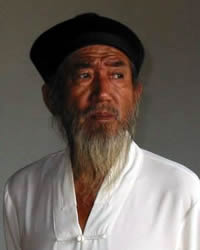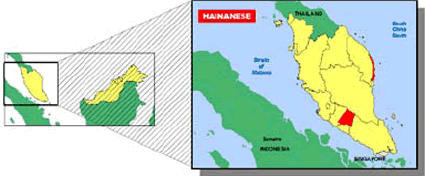Hainanese speaking Chinese constitute the smallest dialect among Chinese in Malaysia. Originally, Hainanese ancestors left the Chinese island of Hainan off the coast of Guangdong in the mid-19th and early 20th centuries in order to seek a better life in Malaysia.
The Hainanese dialect is linguistically part of the Min speech group, to which the Fujian dialects and Teochew also belong. Hainanese became a distinct speech group when early Chinese settlers from the nearby Fujian and Guangdong provinces came and assimilated with the original tribal inhabitants of Hainan Island. The spoken dialect of the Hainanese in Malaysia is very much the same as that in Hainan Island, but it has loanwords borrowed from other languages. Spoken words may vary in pronunciation and tone. The Hainanese speaking Chinese are one of the most urbanized with more than eighty per cent living in towns. They are found all over the country but are more concentrated in the states of Selangor and Malacca.
In the past, the traditional occupational identification of the Hainanese group was coffee shop operators. Presently, many Hainanese-speaking Chinese hold positions in commerce, manufacturing, construction, banking, finance, capital services, and major industries.
Hainanese culture, especially the moral and intellectual aspect, draws from Chinese culture. For instance, parents are expected to train up their children to be good scholars and the young must respect the elder and the elder must love the young.
For most Hainanese speaking families, their religion is no different from the other Chinese groups - a syncretistic mix of several beliefs and practices. They practice a religion mixed with Confucianism, Taoism, Buddhism, and ancestor worship. They label this as Chinese religion. They also worship different deities and visit various types of temples.
The goddess of Mazu, a communal deity, is popularly worshipped by the Hainanese. In fact, many Hainanese associations have their origins in Mazu temples and today it is still common to see Hainanese associations having Mazu altars. Mazu's birthday, which falls on the 23rd day of every third lunar month, is an important occasion of Hainanese communal religious celebration.
Mazu, popularly referred to as Tianhou or the heavenly queen, is traced by a myth to Putian of Fujian Province in China. She was a filial young woman by the name of Lin Moniang of the Song Dynasty. After her young death, it was believed that she saved people in distress at sea and so she was worshipped as their goddess of the sea.
A small percentage of the Hainanese in Malaysia are Christians.
Though the Hainanese perceive themselves as having made it, many in fact are still very poor. Many Hainanese think that good education will pave the way for a better life. Pray that followers of the Way will encounter receptive Hainanese in their quest and be able to point the way to the truly abundant life.
Pray for a Holy Spirit empowerment of Hainanese Christian believers that will result in them winning and discipling others.
Pray for spiritual boldness and openness among the Hainanese in Malaysia.
Pray for the Lord to use Hainanese Christian believers to take the gospel to the Muslim Malays.
Scripture Prayers for the Han Chinese, Hainanese in Malaysia.
Southeast Asia Link – SEALINK, Copyrighted © Used with permission.
| Profile Source: Joshua Project |












